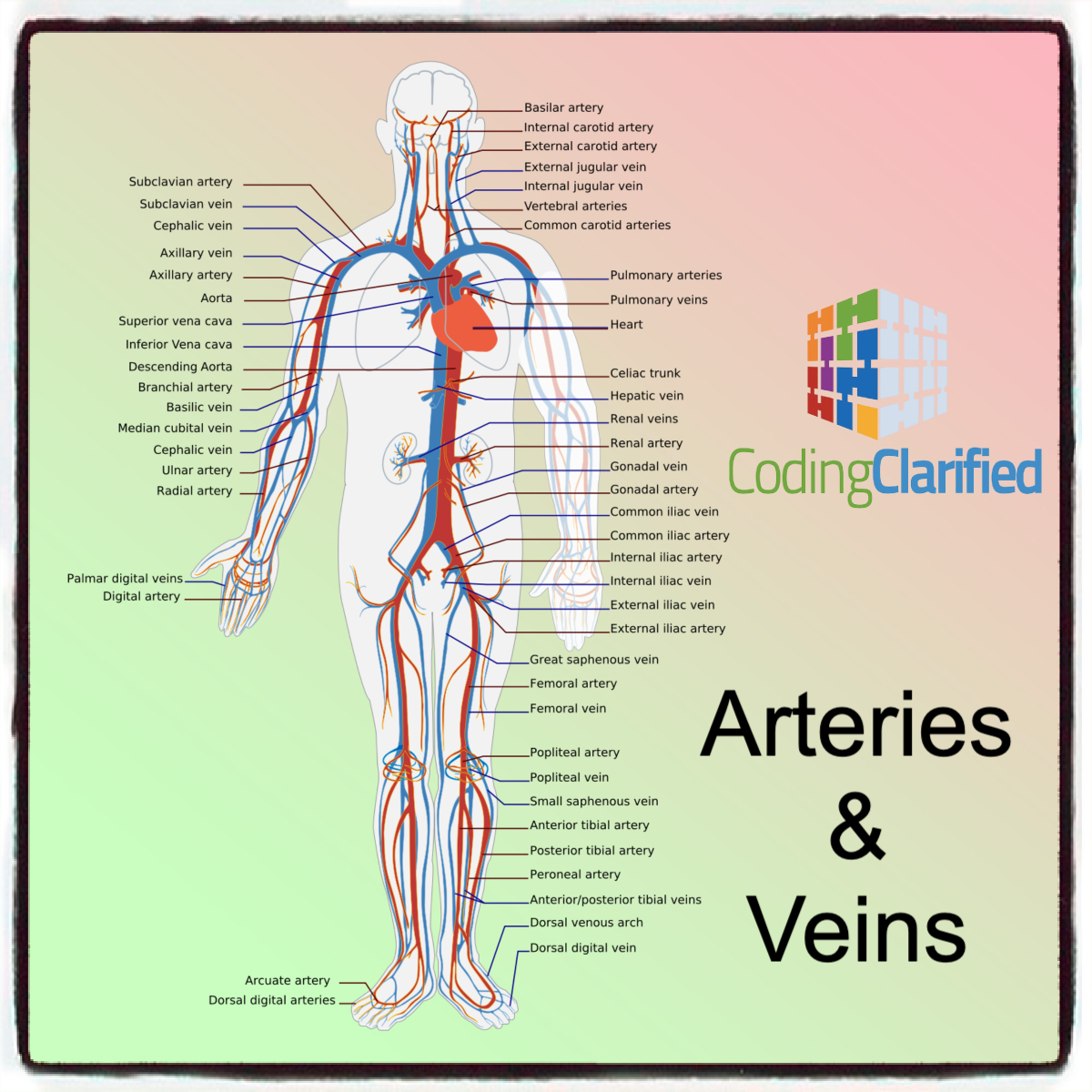Medical Coding for Arteries and Veins
Medical coding for arteries and veins is an essential aspect of healthcare documentation. It ensures accurate billing, proper reimbursement, and clear communication among healthcare providers. Coding arteries and veins involves using specific codes from the ICD-10 (International Classification of Diseases) for diagnoses and CPT (Current Procedural Terminology) for procedures. Additionally, the HCPCS (Healthcare Common Procedure Coding System) may be used for certain medical supplies and services.
In this blog, we’ll delve into how arteries and veins are coded, as well as list the major arteries and veins of the human body.
Arteries and Veins: A Coding Overview
Arteries are blood vessels that carry oxygen-rich blood away from the heart to various parts of the body. Veins, on the other hand, are blood vessels that return deoxygenated blood from the body back to the heart. Properly coding these structures is crucial for identifying cardiovascular diseases and conditions like aneurysms, occlusions, and varicose veins.
When coding for arteries and veins, the coder must be familiar with the anatomical location, the type of condition (e.g., thrombosis, stenosis, or aneurysm), and the procedure being performed (e.g., angioplasty, vein stripping).
ICD-10 Coding for Arteries and Veins
ICD-10-CM (Clinical Modification) codes for arteries and veins focus on conditions related to these blood vessels. These codes often begin with the letter I (for diseases of the circulatory system) and may describe a specific artery, vein, or type of vascular disorder.
For example:
- I63 – Cerebral infarction (referring to blockage in the arteries of the brain)
- I74.9 – Embolism and thrombosis of unspecified artery (general artery blockage)
- I82.9 – Venous embolism and thrombosis, unspecified (general vein blockage)
CPT and HCPCS for Arteries and Veins
When coding procedures, CPT codes are used for surgeries, interventions, and diagnostic tests involving arteries and veins. These codes cover a wide range of procedures including angiography, stent placement, bypass surgery, and vein treatments.
For example:
- CPT 36215 – Selective catheter placement for angiography of arteries
- CPT 33533 – Coronary artery bypass grafting (CABG) procedure
- CPT 37718 – Venous stripping for varicose veins
Major Arteries of the Body
Here is a list of the major arteries in the human body, which are commonly involved in medical coding:
- Aorta – The largest artery in the body, originating from the heart and distributing oxygenated blood to the entire body.
- Coronary Arteries – Branches off the aorta that supplies blood to the heart muscle itself.
- Carotid Arteries – Located in the neck, these arteries supply blood to the brain, neck, and face.
- Subclavian Arteries – Supply blood to the arms and some parts of the chest.
- Brachial Artery – Located in the upper arm, it supplies blood to the arm and hand.
- Femoral Artery – Supplies blood to the lower limbs, running down the thigh.
- Renal Arteries – Supply blood to the kidneys.
- Pulmonary Arteries – Carry deoxygenated blood from the heart to the lungs for oxygenation.
- Iliac Arteries – Supply blood to the pelvis and lower limbs.
Major Veins of the Body
Veins are responsible for returning deoxygenated blood to the heart. Here is a list of some of the major veins:
- Superior Vena Cava – Carries deoxygenated blood from the upper body (head, neck, arms) to the right atrium of the heart.
- Inferior Vena Cava – Carries deoxygenated blood from the lower body (abdomen, pelvis, and legs) to the heart.
- Jugular Veins – These veins in the neck drain blood from the head and neck and return it to the superior vena cava.
- Subclavian Veins – Drain blood from the arms and return it to the superior vena cava.
- Femoral Veins – Drain blood from the legs and return it to the inferior vena cava.
- Renal Veins – Return blood from the kidneys to the inferior vena cava.
- Pulmonary Veins – Carry oxygenated blood from the lungs back to the left atrium of the heart.
- Hepatic Veins – Drain blood from the liver into the inferior vena cava.
Common Procedures Involving Arteries and Veins
Medical professionals may perform various procedures related to arteries and veins. Below are some common procedures and their corresponding CPT codes:
- Angioplasty: A procedure to open narrowed or blocked arteries (e.g., CPT 92920 for coronary angioplasty).
- Stent Placement: Inserting a stent into an artery to maintain blood flow (e.g., CPT 37236 for stent placement in a coronary artery).
- Bypass Surgery: Creating a detour around a blocked artery (e.g., CPT 33533 for coronary artery bypass grafting).
- Vein Stripping: Removing varicose veins from the leg (e.g., CPT 37718 for vein stripping of varicose veins).
- Thrombectomy: Surgical removal of a blood clot from a vein or artery (e.g., CPT 37184 for thrombectomy of a peripheral artery).
Correct coding of arteries and veins is essential for ensuring proper diagnosis, treatment, and reimbursement. By understanding the anatomical details of these vessels and the coding conventions used in ICD-10, CPT, and HCPCS systems, medical coders can accurately document and process claims related to vascular conditions and procedures. Proper coding also aids in the research and study of vascular diseases, helping to advance medical knowledge and care.
By keeping up with the major arteries and veins of the body, as well as the appropriate coding guidelines, coders can improve the efficiency and accuracy of healthcare administration.
Coding Clarified’s AAPC CPC Training course
Let Coding Clarified “clarify” coding for you!
https://codingclarified.com/mastering-online-medical-coding-training/

